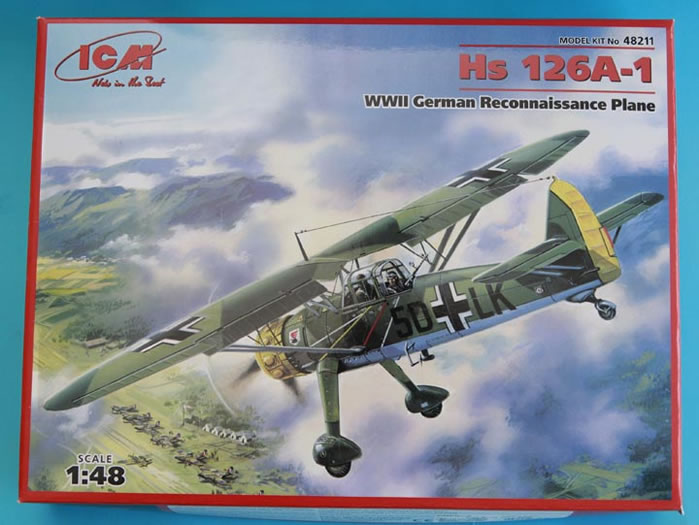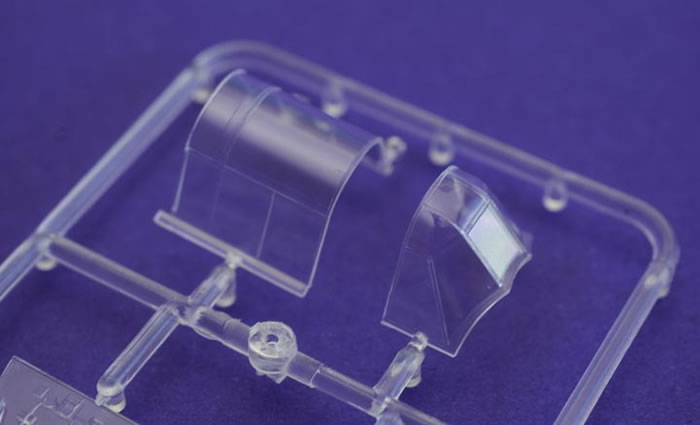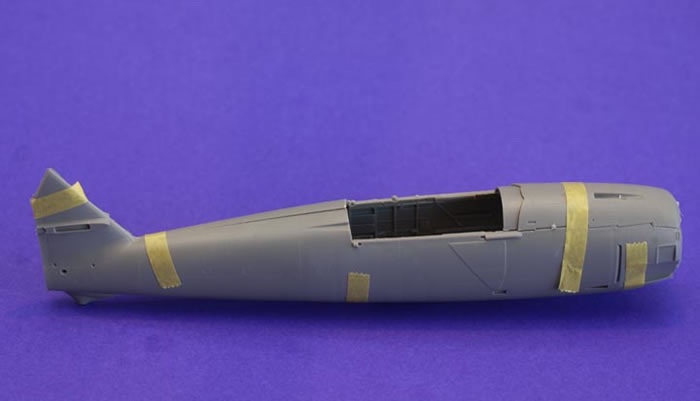|
Henschel Hs 126 A-1

ICM, 1/48 scale
S
u m m a r y |
| Catalogue Number: |
ICM Kit No. 48211 - Henschel Hs 126 A-1 |
| Scale: |
1/48 |
| Contents and Media: |
170 parts (166 in light grey styrene, 4 clear styrene); markings for three options |
| Price: |
Will be available from specialist hobby retailers worldwide |
| Review Type: |
FirstLook |
| Advantages: |
Neglected subject, fine panels lines, great internal and external detail with plenty of options |
| Disadvantages: |
|
| Recommendation: |
A finely produced kit resulting in what is in my estimation ICM's best offering yet.
|
Reviewed by
Cookie Sewell

Eduard's 1/48 scale Albatros D.III Profipack is available online from Squadron.com
The kind folks at the Ukrainian company ICM have finally released their 1/48 scale Hs 126A-1 and on looking into the box it's a gem, I should know I have built the challenging FM Models kit just last year.
ICM's new offering comes in a mid grey slightly soft plastic; spread over 3 sprues, all with commendably small attachment points, fine details and no flash.
170 parts make up the kit, features include all flight surface as separate parts, injected canopies with suitably raised detail and a busy office and detailed power plant.
The instructions are presented over 8 A4 pages and call out colours by Model Master and RLM numbers only. Panel lines are very fine and delicate on the slightly matt plastic, flow marks, ejector pin marks and sink holes are virtually non existent on my sample.
Positive attachment slots for the undercarriage are present in the fuselage, making the alignment of the spindly under cart a more certain affair, unlike the wire pinning I had to undertake on the FM version.
The main wing is supplied in two halves and does have shallow inserts for the location of the cabane and wing struts, these are very shallow and would no doubt benefit from drilling out prior to construction.
The glazed parts are thin and distortion free and include the forward windscreen, central sliding portion, a clear instrument panel with raised detail to depict the flight instruments, the rear cockpit is not forgotten with the radio operator’s work station also moulded in clear. Bringing up the clear parts is a smart landing light that will have to be inserted into the lower wing before the parts are brought together.

The front office made up of 12 parts, the seat is slightly on the thick side, but nothing 2 minutes with a sanding stick wont fix.
The rear office is made up of almost 50 parts covering all the radios, camera bay and machine gun. All this is attached to crisp internal rib detail on the fuselage parts. Looks like it will build into a busy and realistic representation of this work space.

The under fuselage camera port is modelled in the closed position. I have found few references for the door arrangement but as the large fixed camera is supplied in the kit it would be worth thinking about opening the camera lens doors.
Horizontal stabilisers are split in two parts each but the rudder, elevators and flaps are one piece and display suitably thin trailing edges and good fabric effect when required.
The power plant is made up from nine parts and is wrapped in a tricky 3 part cowl that may pose a challenge. This is attached to a 6-part firewall and engine support struts, a nice touch if you want to open the engine up. Many of the smaller external parts that were absent from the FM version are supplied, like the external power generator and various external radiators and air scoops, all in all adding to the complexity and busy external appearance of the kit.
The two fuselage halves fit together with little or no gap and the cartelistic 3 degree off centre tail is faithfully represented in the plastic. This bodes well for the fit of the other parts but only the building will tell. With all those struts supporting a large and heavy wing, they will need to be spot on.

Markings are supplied for 3 machines, 9H/LG2 Germany 1939, 1 H/14 Poland September 1939 both in the standard 70/71 splinter scheme and a machine of 2 H 31 Pz. Greece April 1941 with RLM 04 cowl and tail. The decals are in register and have good colour density but do show signs of ink bleed in the black areas of the codes and balken crosses.

Few stencils are provided other than the fuel triangles.
At last, a mass-produced Henschel 126, and it looks a beauty. Leaving the FM offering well in its dust. I have heard rumours that this kit owes its linage to the Vector resin offering that I tried to prise from our editors hands prior to building the FM kit, not having the Vector kit for comparison I cant say.
To wrap up a finely produced kit of a neglected subject, fine panels lines, great internal and external detail with plenty of opinions to add further details to what is in my estimation ICM's best offering yet.
Purchased by reviewer
Review Text and Images Copyright © 2010 by James Davies
Page Created 17 March, 2010
Last updated
17 March, 2010
Back to HyperScale Main Page
Back to Reviews Page

|
